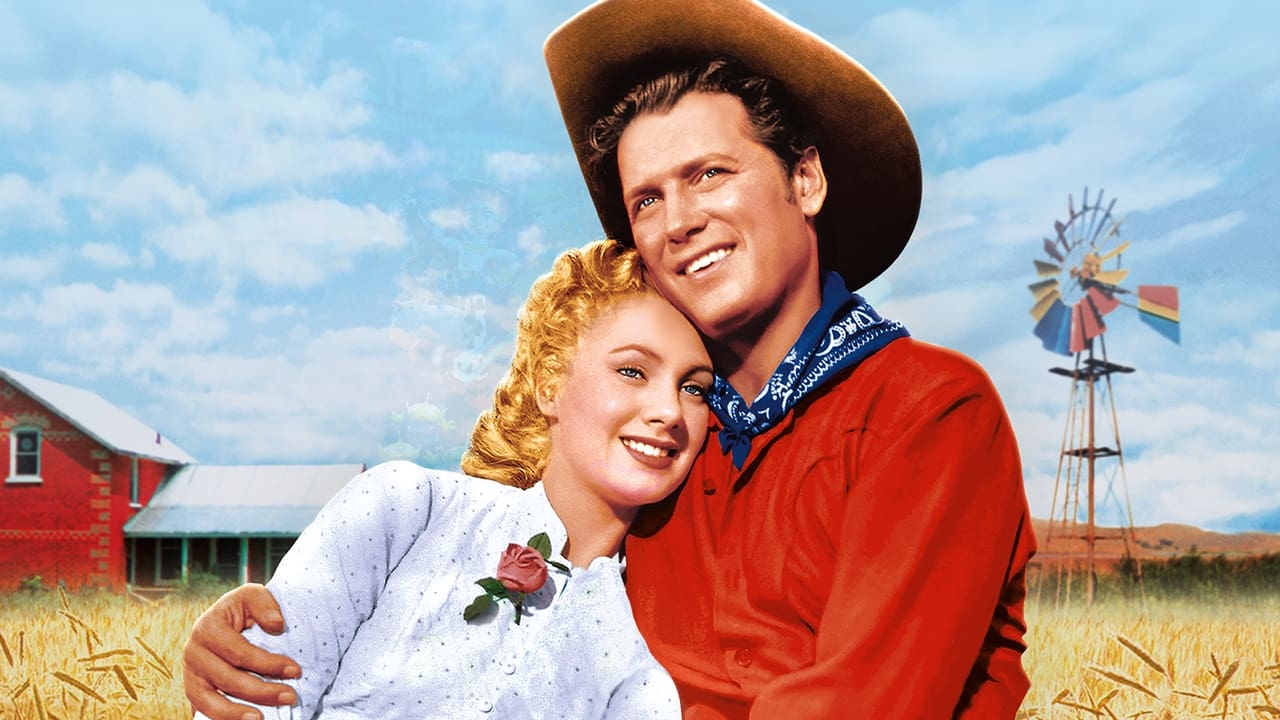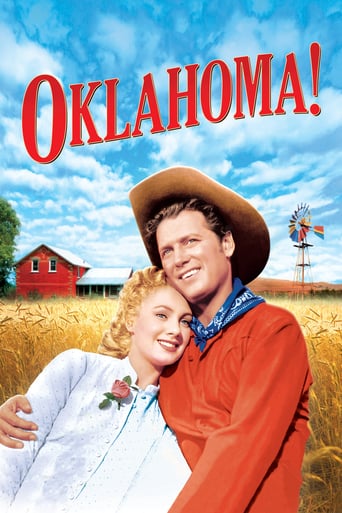

I saw Oklahoma! in its original TODD-AO release at the Egyptian theater in Hollywood in early 1956. Since then I've seen it in all its versions, Cinemascope and Todd-AO, including the TODD-AO re-release at the Egyptian theater in 1985 where it was shown on the original curved TODD-AO screen built for that theater. Seeing the movie on a big screen is a truly amazing experience, almost like seeing a great film made even greater by the large screen. Seeing the film Pan/Scan and in widescreen on TV is nowhere near the large screen experience. It is now shown rarely, if ever on large screens, but the recent restored version (available on Blu-Ray) made from the very degraded 70MM negatives was first shown at the Chinese in Hollywood at the 2014 Turner Festival and in May 2015 at the Academy Awards theater in Beverly Hills. At that showing, the restorers were present and told the audience that the film was so rushed into its premier in New York that apparently no inter-negatives were made which is why restoring the film was so difficult. The restoration is truly great and the large format showings give you a greater appreciation of this excellent musical. As others reviewers have stated, the music,performances, photography, and production are unparalleled. The IMDb listing does not list the incredible 6 track stereo used in the TODD-AO version which sounds like it was recorded yesterday--the 4 track Cinemascope version pales by comparison. 60 years later, it is still the best and most impressive musical of them all. Ask your local theater to schedule at least one showing on a big screen. You'll see why all these reviewers appreciate this great musical.
... View MoreOklahoma! is the greatest musical ever filmed. You may have other personal favorites, but when R&H decided to produce the film version, they micromanaged their baby until it was perfect. They succeeded on all counts-acting, singing, timing, choreography, photography that blows you away. It also shows the darker side in what is seemingly a simple romantic story. Director Zinneman's choice to have threatening Rod Stieger as a counterpart to the sweet story, There is no argument that the songs are performed as the composers wanted, and McRae and Jones signing and performances are unequaled. The movie sets a high bar for any production to cross, and having seen many stage productions, none has the effect of the magnificent movie. I was fortunate enough to see the original release at the Egyptian in Hollywood, and the revival at the same theater 38 years later, both on the marvelous TODD-AO curved screen. Its more impressive on a big screen and I would gladly pay to see this on a large screen. The latest Blue-Ray version look and sounds absolutely beautiful, has impressive 7.1 DTS-HD sound and is a big improvement over the 2005 release which was pretty worn. Thank you 20th Century Fox for restoring this not only historic first Todd-AO film, but allow the firm to be shown as it was originally meant to be seen
... View MoreGreat dancing. Gene Nelson and Charlotte Greenwood at the train station. Plus all the cowboy dancers. Fantasy dream ballet had lovely parts, but evil parts with Jud Fry and evil women were really scary. Of course, Laurey was having a drug-dream via elixir from good ole Ali Hakim. Eddie Albert: what a ham!8/10 the movie. Too much ugliness. Fry living in an underground type shack smokehouse. Ugh. And he must have wanted to marry Laurey and make a home for her. Was he nuts? Yes. Scary? Yes. Goofy? Of course. Bad ppl in dream ballet did not help, either. Fry setting the hay mounds on fire certainly did not endear him to the audience. Jealous? In a rage? Yes. Rod Steiger was also pretty creepy in On the Waterfront, in support of my dear Marlon Brando. Great songs. Gloria Grahame a coy cutie. Shirley Jones and Gordon MacRae were in marvelous voice.More observations: historically, open spacers vs. fencer-inners. Cowboys and ranchers vs. farmers and agriculturalists. Frederick Jackson Turner (not in this movie) was ready to envelop the West in barbed wire fencing. Years before 1912, when Oklahoma became a state, I think? Also year of Titanic disaster. Two years before World War One. The world's first sustained powered airplane 1903 was brought into being by Orville and Wilbur Wright. Motion pictures and automobiles had been invented. Oklahoma movie is what it is. Surrey with the fringe on top. Sell/trade my horse for your goody-filled picnic basket. White man plays Middle Easterner. Good Time Sally wants to two-time or three-time her naive, dancing cowboy. Older woman has no man. Neighborhood Good Time Charlie dreams up a fake limo ride aka that fringed surrey pulled by white stallions. Wicked Wanda tries to steal GT Charlie away from ignorant, backward, beautiful singing farm girl. Take that, you wicked witch. Gordon and Shirley ride off into the sunset, in this movie. 'Tain't so in their Carousel movie, where they get permanently separated by The Pearly Gates. R&H musicals and movies. Oklahoma vicious villain; darkly dressed dance hall women in dream sequence. Carousel cranky husband; best friend villain; spousal abuse and child abuse--glammed up as a "kiss", and darkly dressed evil-carousel-horse-women in fantasy sequence. South Pacific racism; ethnicism; ageism. Cinderella 1957 mean, ugly step- family amid palace splendor (of course, R&H did not invent Cinderella). Flower Drum Song more racism and looking down upon mores of Asian immigrants.
... View MoreThis was the first of the stage-to-screen adaptation of a Rodgers and Hammerstein show, full of the sweetness, humour, rural idyll and dark touches that characterise their work. But rather than focus on the genius of that legendary composer-lyricist duo or the innovativeness of Oklahoma the stage show, I'm going to concentrate on how it is made to work for the screen, and what this production meant for the future of the screen musical.Rodgers and Hammerstein, not wishing to see a disservice done to their material, involved themselves considerably in the making of the picture, and this included selecting the director. To many amateur film buffs and fans of "serious" cinema, Fred Zinnemann may seem like an odd choice, and Oklahoma might appear to be an anomaly in his oeuvre, which is best known for its painstaking realism and heavy-going drama. Zinnemann was of course one of the most bankable directors of this period, having made a number of critical and commercial hits in the early 50s, including 1953's Best Picture Oscar winner From Here to Eternity. But I believe Rodgers and Hammerstein were being quite savvy when they made the choice, and not just blindly plumping for an industry favourite. Oklahoma makes the bold step which MGM, the current champions of the genre, rarely made, of being filmed on location. Few directors had a better feel for the beauty and serenity of the countryside than Zinnemann, so who better to smooth the transition from the enclosure of the stage to the vastness of the plains? Of course, directing a musical is a craft in itself which directors either have or they don't. Zinnemann had no experience in the genre, and while he doesn't have the same flair for complex visual orchestration of the undisputed master Vincente Minnelli, he shoots the numbers in his own sensitive style, which proves very effective for the gentleness of the Rodgers and Hammerstein world. For the relaxed, character-orientated songs like "Surrey with the Fringe on Top" he shows off the beauty of the location to match that of the music. He uses the extra width of the new scope ratio to add little bits of movement to the edges of the screen – a horse flicking its tail or a tree waving in the breeze – complementing the song without being intrusive enough to overshadow it. For "People Will Say We're in Love", there are natural-looking extras in the background whose movements are in time with the tune. With "Poor Jud is Daid", easily the funniest song, the whole thing is shot before a plain background, focusing us entirely on the words and the actors' expressions.For the more crowded dance numbers, most of the credit goes to choreographer Agnes de Mille. De Mille shows a rare sensitivity to every nuance of the music as well the nature of each character, and her influence on the overall look of this picture is so significant she almost deserves a co-director credit. Probably the greatest example of her work in Oklahoma is on the number "Many a New Day". If you listen carefully to the music, you can hear it has a lot of what are called counter rhythms, with often double-time melodies playing under the main tune. De Mille mimics this by having some of the dancers in double-time to the rest, and having each strand of the orchestration matched by a different dance step. It's a pity she didn't work more often in cinema, and also a shame the Oscar for Best Dance Direction had been discontinued. She certainly deserved some sort of award for her valuable input.At this time in musicals story and drama were beginning to take precedence over performance showcasing. It followed then that cast members were being chosen for their acting ability rather than their song-and-dance skills, although at this point it was still mainly the supporting roles that were filled by people who were actors first. Pick of the bunch here is surely Gloria Grahame. Grahame is patently tone-deaf, but she acts each of her songs more than she sings it, bringing the part to life through tone and movement. Besides, her tuneless wailing fits the character nicely. Then there's Eddie Albert as Ali Hakim. Albert probably knew he had the silliest and least convincing character of the whole show, so he just has fun with the role, playing the peddler like a cross between Alan Hale and Chico Marx. The oddest bit of casting is Rod Steiger, who plays Jud like he was still in On the Waterfront. But the gritty intensity of his performance really works, making the character seem like a real menace rather than a comedy figure you can just laugh off. And kudos to "serious" actor Steiger for putting time and attention into getting the part right. Steiger's appearance here represents the greatest departure for casting in musicals. Grahame or Albert could conceivably have appeared in an early 50s MGM musical, but Rod Steiger, never! And in fact, it is these delightful supporting players who really make Oklahoma. Gordon MacCrae and Shirley Jones, who we can assume were chosen for their looks and vocal talent, make for rather bland leads. While these two would do better stuff later on, the fact that they fail to carry the heart of this movie points to the way forward for the genre. It wouldn't be long before such roles would be filled by top dramatic performers like Deborah Kerr, Natalie Wood and Audrey Hepburn, their singing voices dubbed (usually by an uncredited Marni Nixon). For better or for worse, the future of the screen musical belonged to the actors.
... View More